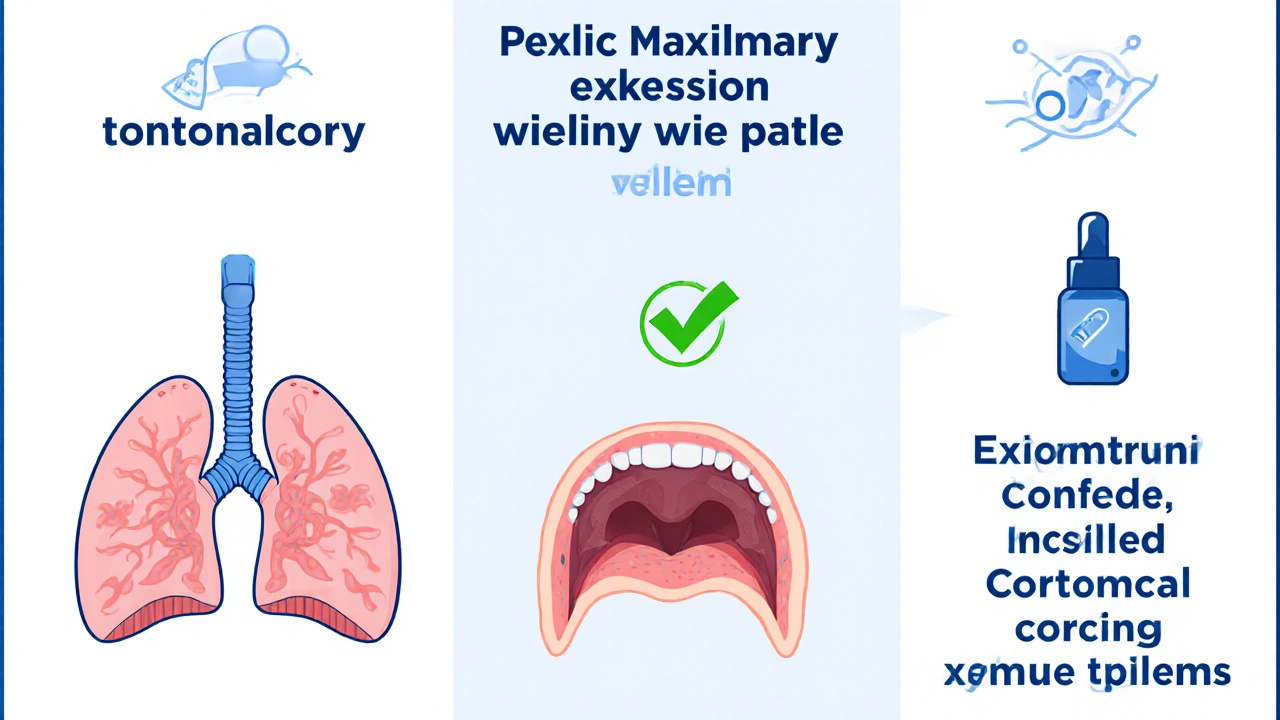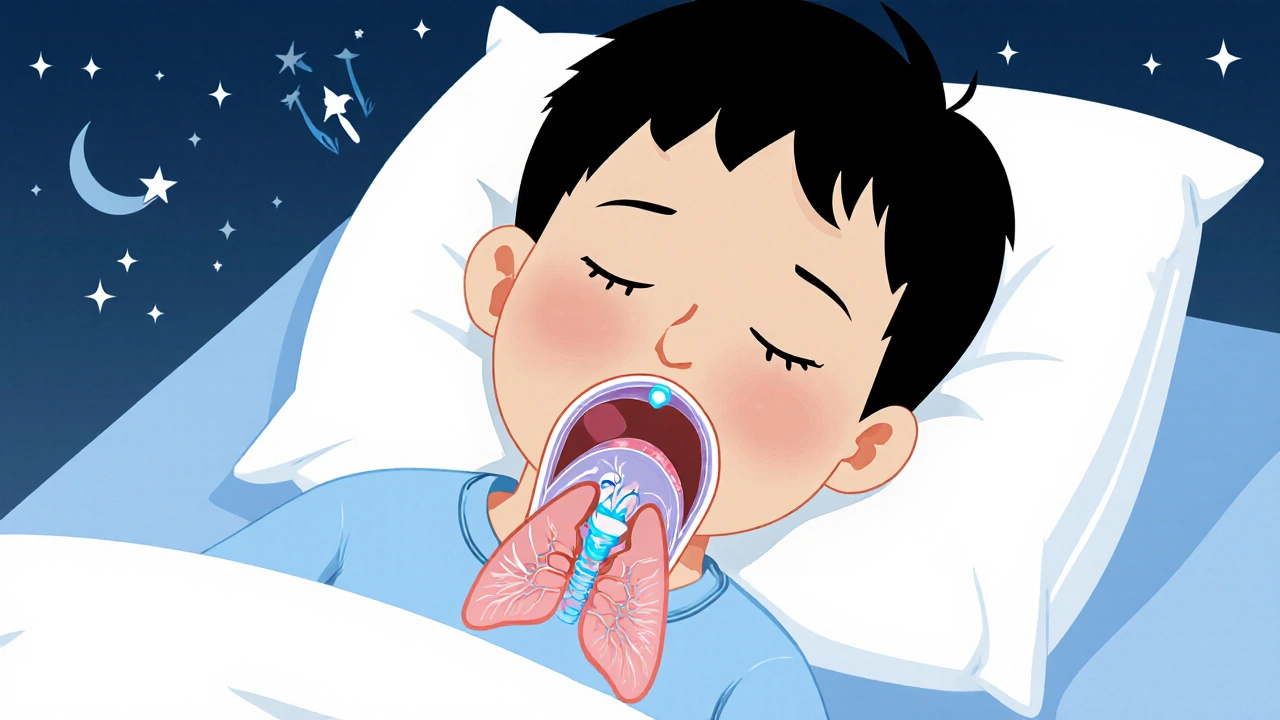What Is Pediatric Sleep Apnea?
When a child stops breathing briefly during sleep-sometimes dozens of times an hour-it’s not just snoring. It’s pediatric obstructive sleep apnea (OSA), a real and treatable condition that can change how your child grows, learns, and behaves. Unlike adult sleep apnea, which often links to weight, in kids it’s usually caused by something simple: enlarged tonsils and adenoids. These are the soft tissues at the back of the throat and nose. When they grow too big, they block the airway while your child sleeps. The result? Broken sleep, low oxygen, and daytime problems like irritability, trouble focusing, or even bedwetting.
The American Thoracic Society says about 1 to 5 out of every 100 children have this. It’s most common between ages 2 and 6, when those tonsils and adenoids are biggest compared to the small size of a child’s airway. Left untreated, it can affect brain development, heart health, and growth. Kids with severe OSA may stop breathing 15 to 30 times every hour. That’s not normal. That’s a medical signal.
Why Tonsils and Adenoids Are the Main Culprits
Think of the airway like a narrow tunnel. In kids, that tunnel is small to begin with. When the tonsils (on the sides of the throat) and adenoids (behind the nose) swell-often from repeated infections or allergies-they take up space that should be for air. It’s like trying to breathe through a straw that’s half blocked. The child struggles to get enough air, wakes up slightly (often without remembering), and the cycle repeats all night.
Doctors don’t just guess. They look at how big the tonsils are using a grading system: Grade 1 is barely noticeable, Grade 4 means they’re touching each other in the middle of the throat. If your child has Grade 3 or 4 tonsils and adenoids, and shows signs like loud snoring, gasping, or mouth breathing at night, OSA is likely. Studies show that removing both the tonsils and adenoids together works better than removing just one. Why? Because OSA isn’t just about one swollen tissue-it’s about the whole airway being crowded. Even if one looks bigger, the other is still contributing to the blockage.
Adenotonsillectomy: The First-Line Treatment
If your child’s sleep study confirms moderate to severe OSA and their tonsils and adenoids are enlarged, the first recommendation is almost always surgery: adenotonsillectomy. This means removing both tissues under general anesthesia. It’s a common procedure, but it’s not minor. About 85 to 90 percent of pediatric OSA cases start here, according to the American Academy of Pediatrics.
Success rates? They vary. In healthy kids with no other issues, 70 to 80 percent see big improvements or full resolution of symptoms. But if your child is overweight, has a craniofacial condition, or has other health problems, the success rate drops to 27 to 50 percent. That’s why doctors don’t just say “remove them and hope.” They check the full picture.
There’s a newer option some specialized centers offer: partial tonsillectomy. Instead of removing the whole tonsil, they take out only the part blocking the airway. This reduces pain, bleeding, and recovery time by about 30 percent. But it’s not available everywhere. Most hospitals still do the full removal. Recovery takes 7 to 14 days. Your child will need soft foods, plenty of fluids, and close watch for bleeding-though serious bleeding happens in only 1 to 3 percent of cases.

When CPAP Is the Answer Instead
Not every child is a good candidate for surgery. If your child has a neuromuscular disorder like cerebral palsy, a rare facial structure problem, or severe obesity, surgery might not fix the problem-or it might be too risky. That’s where CPAP comes in.
CPAP stands for continuous positive airway pressure. It’s a machine that blows gentle, steady air through a mask worn during sleep. The air pressure keeps the throat open so your child can breathe. For kids, the pressure is usually set between 5 and 12 cm H₂O-lower than what adults need. The right pressure is found during a special sleep study called a CPAP titration.
When used correctly, CPAP works extremely well-85 to 95 percent of kids see their breathing interruptions disappear. But here’s the catch: kids hate masks. About 30 to 50 percent of children don’t use it consistently. They feel claustrophobic, the mask leaks, it’s hot, or they keep pulling it off. That’s why success isn’t just about the machine-it’s about finding the right mask (nasal pillows, nasal prongs, or full face), making it part of bedtime routine, and giving time. It can take 2 to 8 weeks for a child to adjust.
CPAP is also used after surgery if symptoms come back. About 17 to 73 percent of kids still have OSA after tonsil removal, especially if they’re overweight or have other conditions. In those cases, CPAP isn’t a backup-it’s the next step.
Other Treatments: What Else Can Help?
Surgery and CPAP aren’t the only options. For mild cases, doctors sometimes try non-invasive methods first.
Inhaled corticosteroids like fluticasone (88-440 mcg daily) can shrink swollen adenoids and tonsils by reducing inflammation. It takes 3 to 6 months to see results, but it works for about 30 to 50 percent of kids with mild OSA. It’s not a cure, but it can delay or avoid surgery.
Rapid maxillary expansion is an orthodontic device that gently widens the upper jaw over 6 to 12 months. It helps kids whose narrow palate is squeezing the airway. Success rates are 60 to 70 percent in those with the right anatomy.
Montelukast, a daily pill used for asthma and allergies, is being studied for OSA. It blocks chemicals that cause tissue swelling. Some research shows it reduces symptoms in mild cases, but it takes months and isn’t approved specifically for sleep apnea yet.
And there’s new tech: hypoglossal nerve stimulation. It’s a tiny implant that gently stimulates the tongue muscle to keep the airway open. It got FDA approval for select pediatric cases in 2022, but it’s only used in extreme cases where nothing else works.

What Happens After Treatment?
Even after surgery or starting CPAP, the work isn’t done. Kids grow. Their faces change. Their airways change too. That’s why follow-up is critical.
The American Thoracic Society recommends a repeat sleep study 2 to 3 months after surgery to make sure the OSA is truly gone. If symptoms return-snoring, restless sleep, daytime tiredness-it could mean new blockages, weight gain, or incomplete surgery.
For CPAP users, masks need to be refitted every 6 to 12 months as your child’s face grows. A mask that fit last year might leak now. Pressure settings might need adjusting too. Most problems fix themselves with a simple tweak-no new sleep study needed.
And remember: even if your child seems fine now, untreated OSA can lead to long-term problems. Poor school performance, high blood pressure, and even heart strain are real risks. That’s why treating it isn’t optional-it’s essential for healthy development.
Real-Life Choices: What Should You Do?
Here’s how to think about it:
- If your child is 3 to 5 years old, has loud snoring, enlarged tonsils (Grade 3-4), and no other health issues → adenotonsillectomy is the best first step.
- If your child is overweight, has Down syndrome, cerebral palsy, or a small jaw → CPAP is likely the better choice.
- If snoring is mild and no sleep study was done yet → ask about steroid nasal spray or a wait-and-see approach with monitoring.
- If your child had surgery but still snores → CPAP or a second sleep study is next.
There’s no one-size-fits-all. But the goal is always the same: help your child breathe easily at night so they can wake up rested, focused, and healthy.


steffi walsh
November 19, 2025 AT 05:34Holly Powell
November 19, 2025 AT 11:43Riohlo (Or Rio) Marie
November 20, 2025 AT 03:53Conor McNamara
November 20, 2025 AT 05:06Emanuel Jalba
November 21, 2025 AT 17:29Heidi R
November 22, 2025 AT 11:31Brenda Kuter
November 24, 2025 AT 02:03Shaun Barratt
November 24, 2025 AT 04:37Gabe Solack
November 24, 2025 AT 18:14Yash Nair
November 26, 2025 AT 16:20Bailey Sheppard
November 27, 2025 AT 21:06Girish Pai
November 29, 2025 AT 08:42Leilani O'Neill
December 1, 2025 AT 03:01